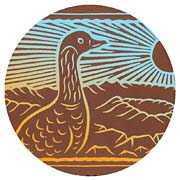COURTESY PHOTO
Recently recovered Nene 817, right, has been seen strutting around with a female at Haleakala National Park.
|
|
New life for Nene 817
WAILUKU » About a half a year after a near-fatal accident with a vehicle at Haleakala National Park, an endangered nene goose not only has recovered but also has found its old mate and returned to the area where he was injured.
Nene 817 -- the number on his leg band -- is strutting around with a female in Haleakala National Park.
 "We believe it's his old mate," said park wildlife biologist Kathleen Natividad Bailey.
"We believe it's his old mate," said park wildlife biologist Kathleen Natividad Bailey.
The nene, whose species name is Branta sandvicensis, was found near a park road junction in early March, with his bones exposed and multiple abrasions.
A veterinarian determined there were no broken bones.
In the beginning, he couldn't eat or walk and could barely hold up his head, she said.
"I really didn't think he was going to make it," said Bailey.
Bailey said she took him home during the weekend, cleaned his wounds, and kept him warm with a heater and blanket.
Following procedures suggested by wildlife officials, Bailey said she fed Ensure energy shakes and Pedialyte hydration solution through a tube into the stomach of Nene 817 for at least a week.
The nene was later taken to park facilities for examination and care.
Joy Tamayose, another park wildlife biologist, took Nene 817 home the next weekend and fed it hourly for about three days.
Bailey said Nene 817 started standing and walking again after two to three weeks.
"It was still kind of wobbly," she said.
Placed in a pen next to the biologists' office at the park, the nene was also provided with ohelo berries and other natural food picked by park staff members.
Nene 817 was put into a larger pen by mid-April and improved steadily.
About two months after being injured, biologists left the pen open and Nene 817 walked out to return to the wild.
"This particular bird had a will to live," she said.
Bailey said there are an estimated 250 to 350 nene in Haleakala and some 1,000 to 1,200 nene statewide.
Bailey reminds the public to slow down while driving through the park and not to feed the nene because it can change the pattern of their behavior and put them in danger.
Because some motorists have fed the birds, some nene approach vehicles to obtain food, she said.
Bailey said the road up to the summit also cuts across the nene's nesting area and that the birds are territorial.
Unfortunately, Nene 817 has been seen walking on the road.
"They're creatures of habit and will return to their territory," Bailey said.

